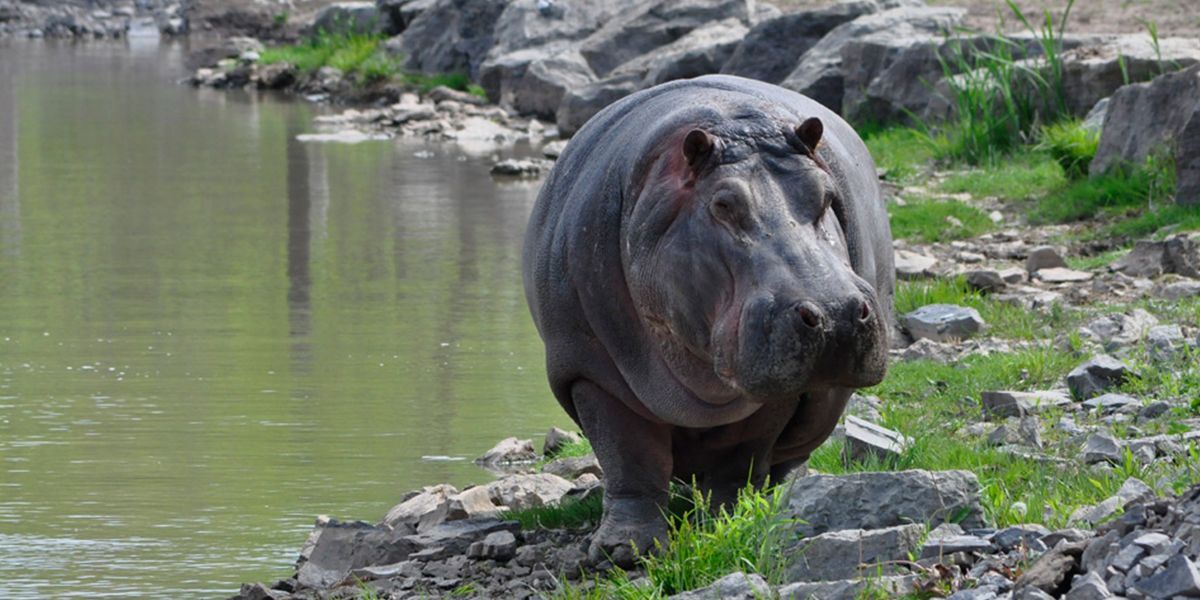Hippopotamus
The Hippopotamus, or Hippo is the third largest land animal after the elephant and rhinoceros. It is native to Sub-Saharan Africa with the largest populations today found in Zambia and Tanzania. It is semi-aquatic and inhabits rivers, lakes and mangrove swamps. Despite the fact that it spends a lot of time in the water the hippo is not a very good swimmer.
Hippos have an average weight of 1500 kilograms (3300 pounds) but some large males reach 2000 kilograms (4400 pounds). They do not exhibit distinct sexual dimorphism. They can run at 30 km/h (19m/h) over a short distance.
They congregate in groups as large as a hundred animals. Males are territorial in their water environment. They are essentially herbivores but will sometimes eat carrion.
They are semi-aquatic animals that spend the day asleep in lakes, swamps and rivers and then stay awake at night looking for grass to graze on. They can travel up to 10km in search of fresh grass. Most hippo species make their habitat in freshwater but some populations in West Africa can be found dwelling in saltwater.
Hippos are known for their large and round appearance, along with their short ears, bulbous eyes, and impressively large teeth. On average, an adult male weighs 1500-1800kg/3300-4000lbs and a female weighs 1300-1500kg/2866-3300lbs. Some males however have grown as large as 4000kg- which is almost 10000lbs and evidence suggests that male hippos continue to grow throughout their lives.
Given their size, they are the third largest land animal after Elephants and Rhinoceros. They communicate with each other using grunts, snorts and bellows. A pod of hippos is usually led by one dominant male who marks his territory using urine or faeces. The pod is made up of younger females and males and the males must be submissive to the leader in order to remain in the pod.
The males get into vicious fights for territory because territory comes with food, water and mating rights. Interestingly, this territorial behaviour seems to be exhibited only when in or around water as it is usually not observed during grazing sessions on land.
Even though hippos have thick short legs, they are able to run up to 30km/hr and can hold their breath underwater for 5-6 minutes at a time. Regardless, they are not generally good swimmers.
Hippos have an average weight of 1500 kilograms (3300 pounds) but some large males reach 2000 kilograms (4400 pounds). They do not exhibit distinct sexual dimorphism. They can run at 30 km/h (19m/h) over a short distance.
They congregate in groups as large as a hundred animals. Males are territorial in their water environment. They are essentially herbivores but will sometimes eat carrion.
They are semi-aquatic animals that spend the day asleep in lakes, swamps and rivers and then stay awake at night looking for grass to graze on. They can travel up to 10km in search of fresh grass. Most hippo species make their habitat in freshwater but some populations in West Africa can be found dwelling in saltwater.
Hippos are known for their large and round appearance, along with their short ears, bulbous eyes, and impressively large teeth. On average, an adult male weighs 1500-1800kg/3300-4000lbs and a female weighs 1300-1500kg/2866-3300lbs. Some males however have grown as large as 4000kg- which is almost 10000lbs and evidence suggests that male hippos continue to grow throughout their lives.
Given their size, they are the third largest land animal after Elephants and Rhinoceros. They communicate with each other using grunts, snorts and bellows. A pod of hippos is usually led by one dominant male who marks his territory using urine or faeces. The pod is made up of younger females and males and the males must be submissive to the leader in order to remain in the pod.
The males get into vicious fights for territory because territory comes with food, water and mating rights. Interestingly, this territorial behaviour seems to be exhibited only when in or around water as it is usually not observed during grazing sessions on land.
Even though hippos have thick short legs, they are able to run up to 30km/hr and can hold their breath underwater for 5-6 minutes at a time. Regardless, they are not generally good swimmers.
Fun Facts
Hippos once lived as far north as the Nile in Egypt and the Levant. There are 5 subspecies of the hippopotamus based on location.

scientific classification
Kingdom
Animalia
Phylum
Chordata
Class
Mammalia
Order
Artiodactyla
Family
Hippomidea
Genus
Hippopotamus
Species
H. amphibius
did you know?
The name “hippopotamus” comes from the ancient Greek meaning River Horse. However, the hippo is thought to share a common ancestor with whales.
Hippos live 40 – 50 years in the wild. One female in a zoo lived to be 61.
Populations are on the decline due largely to poaching.
Where to find us
Our pair of Hippos are named Bobo and Gladis. They live across from the giraffes and spend much of their time in their large pool



